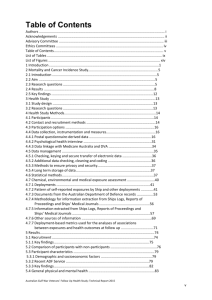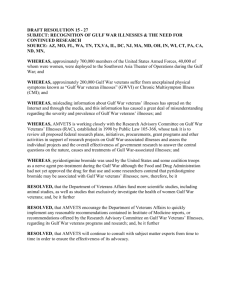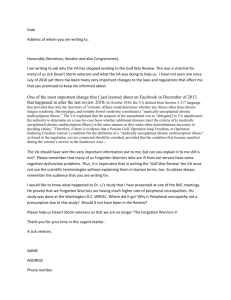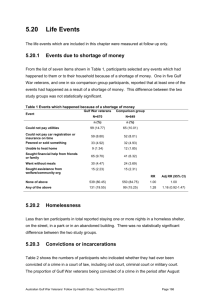Cancer incidence
advertisement
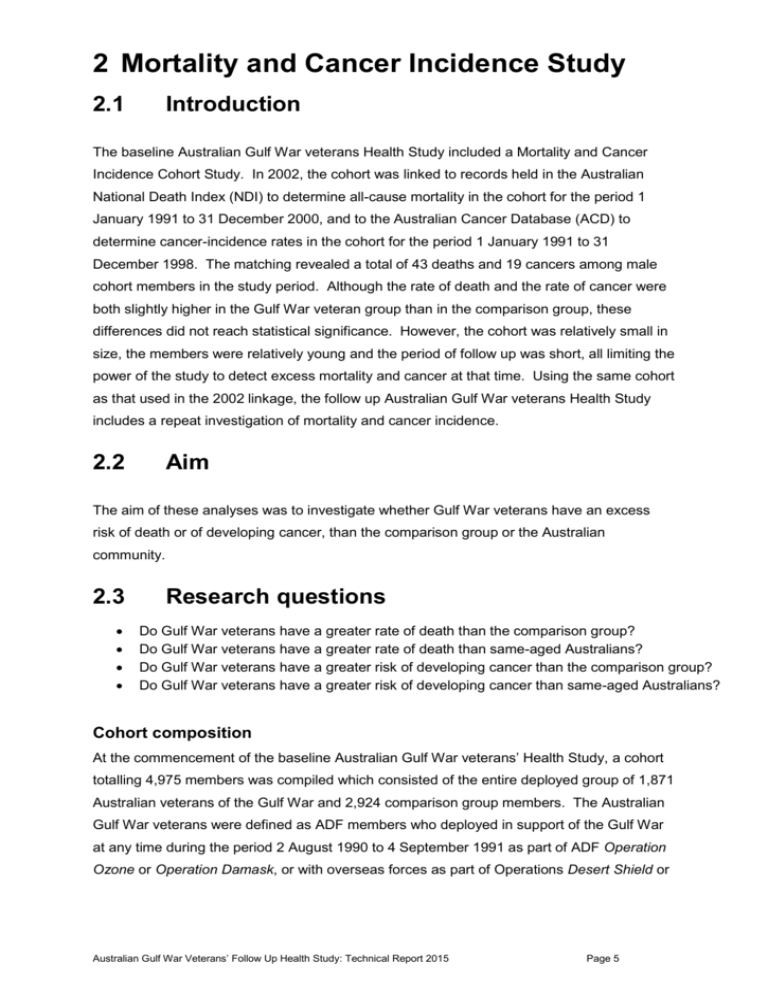
2 Mortality and Cancer Incidence Study 2.1 Introduction The baseline Australian Gulf War veterans Health Study included a Mortality and Cancer Incidence Cohort Study. In 2002, the cohort was linked to records held in the Australian National Death Index (NDI) to determine all-cause mortality in the cohort for the period 1 January 1991 to 31 December 2000, and to the Australian Cancer Database (ACD) to determine cancer-incidence rates in the cohort for the period 1 January 1991 to 31 December 1998. The matching revealed a total of 43 deaths and 19 cancers among male cohort members in the study period. Although the rate of death and the rate of cancer were both slightly higher in the Gulf War veteran group than in the comparison group, these differences did not reach statistical significance. However, the cohort was relatively small in size, the members were relatively young and the period of follow up was short, all limiting the power of the study to detect excess mortality and cancer at that time. Using the same cohort as that used in the 2002 linkage, the follow up Australian Gulf War veterans Health Study includes a repeat investigation of mortality and cancer incidence. 2.2 Aim The aim of these analyses was to investigate whether Gulf War veterans have an excess risk of death or of developing cancer, than the comparison group or the Australian community. 2.3 Research questions Do Gulf War veterans have a greater rate of death than the comparison group? Do Gulf War veterans have a greater rate of death than same-aged Australians? Do Gulf War veterans have a greater risk of developing cancer than the comparison group? Do Gulf War veterans have a greater risk of developing cancer than same-aged Australians? Cohort composition At the commencement of the baseline Australian Gulf War veterans’ Health Study, a cohort totalling 4,975 members was compiled which consisted of the entire deployed group of 1,871 Australian veterans of the Gulf War and 2,924 comparison group members. The Australian Gulf War veterans were defined as ADF members who deployed in support of the Gulf War at any time during the period 2 August 1990 to 4 September 1991 as part of ADF Operation Ozone or Operation Damask, or with overseas forces as part of Operations Desert Shield or Australian Gulf War Veterans’ Follow Up Health Study: Technical Report 2015 Page 5 Desert Storm. They were primarily Naval personnel (84%) and men (98%). Comparison group members were randomly drawn from a population of 26,411 ADF personal who were in operational units at the time of the Gulf War but who were not deployed to that conflict. The comparison group was frequency matched to the Gulf War veteran group by sex, 3-year age band, service branch (Royal Australian Navy, Australian Army, Royal Australian Air Force), 2-rank categories (Officer versus other ranks) for Army personnel, and 2-task categories (aircrew versus non-aircrew) for the Air Force. There was some oversampling of eligible Army and Air Force comparison group members because the total numbers in these service branches were very low relative to the Navy, and a lower participation rate was anticipated in the comparison group relative to the Gulf War veterans’ group. Further details regarding the eligibility criteria for each study group are shown in Appendix 2. The cohort for the Mortality and Cancer Incidence Study, in 2002 and again at follow up, comprised 4,793 members. This was the entire original cohort minus two comparison group members who, during the baseline Health study, declined to participate in the Mortality and Cancer Incidence Study. Registry linkage Approval for both the NDI and ACD linkage was obtained from the Human Research Ethics Committees representing the AIHW, Monash University, the ADF and DVA. Additional approvals for the ACD linkage were obtained from the each of the Human Research Ethics Committees representing the Australian State and Territory cancer registries respectively. In July 2011 a dataset, including the full name, date of birth, last known state and last contact date for the cohort members, was provided to the AIHW for linkage to the NDI and the ACD. At the time of the linkage, the NDI was complete up to 30 November 2010 and the ACD was complete up to 31 December 2008. Data returned from the NDI included the identifying information (e.g. full name and date of birth) for the NDI record that appeared to match a cohort member, and also date of death and all causes of death coded in International Classification of Diseases (ICD) Version 10 and ICD Version 9 codes. Returned matches were independently reviewed by two members of the Monash research team to identify those to be accepted as likely true matches. Data returned from the ACD included identifying information for the ACD record that appeared to match a cohort member in the case that the cohort member had participated in the cross-sectional component of the baseline Gulf War veterans Health Study. For cohort Australian Gulf War Veterans’ Follow Up Health Study: Technical Report 2015 Page 6 members who had not participated in the cross-sectional component of the baseline Gulf War veterans Health Study, data returned for matches to the ACD were deidentified. Other ACD data included for all matches included date of cancer diagnosis, site of body (topography), histology (affected tissue type), state in which the cancer was diagnosed, date of death (if applicable) and the ICD-10 codes for the type of cancer. Statistical analysis The cohort was followed-up from 1st January 1991 to 30th of November 2010 for mortality and 31st of December 2008 for cancer incidence. These periods were used to calculate total person-time. Data were analysed using Stata Version 12 and a 5% level of significance was used in interpreting statistical significance. Box 1 describes the ICD 10 and ICD 9 codes used for each classification of cause of death and cancer type. Box 1 Codes used to categorise causes of death and types of cancer. Causes of Death [ICD9; ICD10 codes] Types of cancer [ICD9; ICD10 codes] All-cause [001-999;A00-Y99] All malignant neoplasms [C00-C97;D45- Cancer [140-239; C00-D48] D46; Cardiovascular diseases [390-459; I00-I99] Lip cancer [C00] All External causes [800-999; V01-Y98] Colorectal [C18-C20] Intentional self-harm [950-959; X60-X84] Other digestive organs [C15 - C17; C21- Transport accidents [800-848; V01-V99] C26] D47.1; D47.3] Lung, trachea and bronchus [C33-C34] Melanoma [C43] Prostate [C61] Testis [C62] Kidney [C64] Brain and other CNS cancers [C70-C72] Thyroid [C73] All lymphomas [C81-C85; C88; C90-C91] Leukemia [C91-C95] For comparison with Australian population rates, cancer and death data for the general Australian population were obtained from AIHW. Using the population rates, expected number of deaths or cancer cases were calculated for each age group and calendar year of follow-up. The expected numbers of deaths or cancers were then compared with the cohort Australian Gulf War Veterans’ Follow Up Health Study: Technical Report 2015 Page 7 observed numbers to calculate Standardised Mortality Ratios (SMRs) and Standardised Incidence Ratios (SIRs). In keeping with usual practice, and for ease of presentation, the SMRs and the SIRs and their 95% confidence intervals were multiplied by 100. Values over 100 represent increased risk of death or cancer and values below 100 represent decreased risk of death or cancer. A value of 100 is where the risk of death or cancer is the same as that in the Australian population. The rate of death or cancer in the Gulf War veteran group was compared with the rate of death or cancer in the comparison group of the cohort using hazard ratios (HRs). Hazard ratios were calculated using the Cox regression model.22 The hazard ratios were adjusted (adj HR) for branch of service (Navy; Army; Air Force), rank (Commissioned Officer (CO); non-commissioned officer (NCO); other ranks) and age (<20; 20-24; 25-34; >=35 years), each estimated as at August 1990, the approximate commencement date of the Gulf War. 2.4 Results Because of the very small proportion of women in the cohort (approximately 2%) results for the 4,680 men in the cohort (1,833 Gulf War veterans and 2,847 comparison group) are presented in the tables in this chapter. There were no female deaths in either group identified during the NDI linkage over the study period. A total of four cancers, all breast cancers, were identified for females from the ACD linkage during the study period. These four cancers were all among members of the comparison group. Men in the cohort averaged 47.7 years of age (sd 6.38) at 30 November 2010 (the date to which mortality data was available). A breakdown of the cohort into age category at 30 November 2010, service branch at the time of the Gulf War and rank at the time of the Gulf War is shown in Table 1 for each study group. The Gulf War veteran group had a similar age and rank composition to the comparison group. There were proportionately fewer Army and Air Force members in the Gulf War veteran group, reflecting some over-sampling for these service branches in the comparison group. Australian Gulf War Veterans’ Follow Up Health Study: Technical Report 2015 Page 8 Cohort characteristics Table 1 Demographic characteristics for the male members of the cohort Characteristic Gulf War veterans Comparison group Whole cohort N=1,833 N=2,847 N=4,680 n (%) n (%) n (%) 35 – 44 742 (40.5) 1,083 (38.0) 1,825 (39.0) 45 – 54 863 (47.1) 1,368 (48.1) 2,231 (47.7) 55+ 228 (12.4) 396 (13.9) 624 (13.3) Expected age in years at 30 November 2010 between groups p-value = 0.16 Service branch at August 1990 Navy 1,558 (85.0) 2,088 (73.3) 3,646 (77.9) Army 115 (6.3) 319 (11.2) 434 (9.3) Air Force 160 (8.7) 441 (15.5) 600 (12.8) between groups p-value <0.001 Rank at August 1990 Officer Non-commissioned Officer Enlisted rank 405 (22.1) 720 (25.3) 1,125 (24.0) 1,168 (63.7) 1,676 (58.9) 2,844 (60.8) 260 (14.2) 451 (15.8) 711 (15.2) between groups p-value = 0.004 Mortality The number of deaths observed in each study group, and the number expected in the Australian population of same-aged men, are shown in Table 2 for the period 1 January 1991 to 30 November 2010. In total 108 deaths were observed, comprising 2.3% of the cohort. There were 49 deaths in the Gulf War veteran group and 59 deaths in the comparison group. In both study groups the all-cause mortality was lower than that in the Australian male population however this difference was statistically significant only for the comparison group (all cause SMR=59, 95% CI 45-76), while it did not quite reach statistical significance for the Gulf War veterans (all cause SMR=77, 95% CI 58-102). Mortality from all-external causes was also statistically significantly lower in the comparison group than in the same-aged Australian male population. There were no significant differences between the Gulf War veterans and the Australian male population, and between the comparison group and the Australian male population, for all other causes of death. Australian Gulf War Veterans’ Follow Up Health Study: Technical Report 2015 Page 9 Table 2 Mortality rates for the Gulf War veterans and comparison group relative to the Australian male population Gulf War veterans person years = 36,065.1 N = 1,833 Cause of death Comparison group person years = 56,139.1 N = 2,847 Observed Expected SMR (95% CI) Observed Expected SMR (95% CI) All-cause 49 63.7 77 (58–102) 59 100.8 59 (45–76) Cancer 16 14.0 115 (70–187) 14 22.6 62 (37–104) Cardiovascular diseases 5 10.8 46 (19–111) 11 17.5 63 (35–114) All External causes 17 24.3 70 (43–113) 23 37.5 61 (41–92) Intentional selfharm 6 9.9 60 (27–134) 9 15.4 59 (30–113) Transport accidents 7 6.4 110 (52–231) 10 9.8 103 (55–191) Table 3 shows the number of deaths in each study group, as a proportion of group size, and the ratio of deaths in the Gulf War veteran group relative to those in the comparison group. There were no statistically significant differences in mortality rates between the Gulf War veterans and the comparison group. It is worth noting that deaths from intentional self-harm were very similar in the two groups. However, there was an overall pattern of the adjusted HRs for all deaths and all causes of death (except for deaths from cardiovascular disease) being slightly greater in the Gulf War veteran group. Table 3 Mortality rates for the Gulf War veterans relative to the comparison group Gulf War veterans Comparison group N = 1,833 N=2,847 Cause of death n (%) n (%) Adj HR (95% CI) All causes of death 49 (2.7) 59 (2.1) 137 (94 – 202) Cancer 16 (0.9) 14 (0.5) 182 (88 – 374) Cardiovascular diseases 5 (0.3) 11 (0.4) 79 (27 – 229) All External causes 17 (0.9) 23 (0.8) 119 (63 – 225) Intentional self-harm 6 (0.3) 9 (0.3) 112 (39 – 317) Transport accidents 7 (0.4) 10 (0.4) 119 (45 – 316) Cancer incidence The number of cancers observed in each study group, and the number expected in the Australian population of same-age men, are shown in Table 4 for the period 1 January 1991 to 30 December 2008. In total 115 cancers were observed, affecting about 2.5% of the total male cohort; 49 (2.6%) in the Gulf War veteran group and 66 (2.3%) in the comparison Australian Gulf War Veterans’ Follow Up Health Study: Technical Report 2015 Page 10 group. In both study groups cancer incidence from all-causes, and from the specific causes tabulated, were not statistically significantly different from those in the same aged Australian male population, apart from a significant excess of thyroid cancer in the comparison group. The other finding of note is the higher than expected number for brain cancers in the Gulf War veterans, although this did not reach statistical significance and was based on very small numbers. Table 4 Cancer incidence rates for the Gulf War veterans and comparison group relative to the Australian male population Gulf War veterans person years = 32,664.7 N = 1,833 Cancer type Comparison group person years = 50,797.7 N = 2,847 Observed Expected SIR (95% CI) Observed Expected SIR (95% CI) All malignant neoplasms 49 49.4 99 (76-133) 66 79.4 83 (65-107) Colorectal ** 4.5 89 (33-237) 7 7.3 95 (45-200) Other digestive organs 6 3.3 184 (83-410) 5 5.3 94 (39-226) Brain and other CNS cancers ** 1.7 238 (89-635) ** 2.7 38 (53-267) Melanoma 11 10.8 102 (56-184) 14 17.2 81 (48-137) Prostate 8 5.0 161 (81-323) 6 8.3 73 (33-161) Testis ** 3.9 52 (13-207) ** 5.9 34 (8-135) Kidney ** 1.7 58 (8-414) 5 2.8 179 (75-431) Thyroid ** 1.1 91 (13-647) 5 1.7 289 (120-693) Lung, trachea and bronchus All lymphomas ** 2.4 42 (6-300) ** 3.9 52 (13-207) ** 5.1 39 (10-156) 8 8.2 98 (49-196) Leukaemia ** 1.7 59 (8-420) ** 2.7 149 (56-397) Lip cancer ** 1.7 173 (56-537) ** 2.8 109 (35-338) Other cancer types 6 8.2 73 (33-163) 8 13.2 61 (30-122) ** Observed number of cancer not displayed because of small numbers (<5 cases). Table 5 shows the ratio of incident cancers in the Gulf War veteran group relative to those in the comparison group. There were no statistically significant difference in the overall cancer incidence rates between the Gulf War veterans and the comparison group. While none of the specific cancer types were found to be statistically significantly higher in the Gulf War veterans, there were some types of cancer (e.g. brain and prostate) where the Adj HR was greatly in excess of one, but the confidence intervals were very wide because of small numbers. Australian Gulf War Veterans’ Follow Up Health Study: Technical Report 2015 Page 11 Table 5 Cancer incidence rates for the Gulf War veterans relative to the comparison group Gulf War veterans N = 1,833 Cancer type Comparison group N=2,847 n (%) n (%) Adj HR (95% CI) All malignant neoplasms 49 (2.7) 66 (2.3) 120 (83–173) Colorectal cancer ** 7 (0.2) 92 (28–308) Other digestive organs 6 5 (0.2) 169 (50–571) Brain ** Melanoma 11 (0.6) 14 (0.5) 119 (54–262) Prostate 8 (0.4) 6 (0.2) 209 (72–603) Testis ** (0.3) ** 513 (67–3924) ** 170 (27–1078) ** Observed and expected values not displayed because of small numbers (<5 cases). 2.5 Key findings In the 20 year period since the Gulf War, there have been proportionately fewer deaths in the male Gulf War veteran group compared to the same aged Australian male population, and, while not quite reaching statistical significance, slightly more overall deaths and deaths from cancer occurred in the male Gulf War veteran group relative to the comparison group. In the same time period, mortality from all-external causes, has been statistically significantly lower in the male comparison group than in the same aged Australian male population. In the 18 year period since the Gulf War, there have been no statistically significant differences in cancer incidence of any type between the male Gulf War veterans, the male comparison group members and the same-aged Australian male population. While the results were suggestive of some types of cancer (eg brain and prostate) being higher than expected among the Gulf War veterans when compared with the comparison group, these were based on very small numbers and therefore the possibility of these findings being observed by chance could not be excluded in the current analysis. There were too few deaths or cancers among females in the study group to make any meaningful interpretation. The power of the study to detect excess mortality and cancer continues to be limited by the fact that the cohort was still quite young at 30 November 2010, with approximately 40% aged between 35-44 years, and the period of follow up is still relatively short for the purpose of detecting disease-related deaths or cancers of long-latency. Australian Gulf War Veterans’ Follow Up Health Study: Technical Report 2015 Page 12


